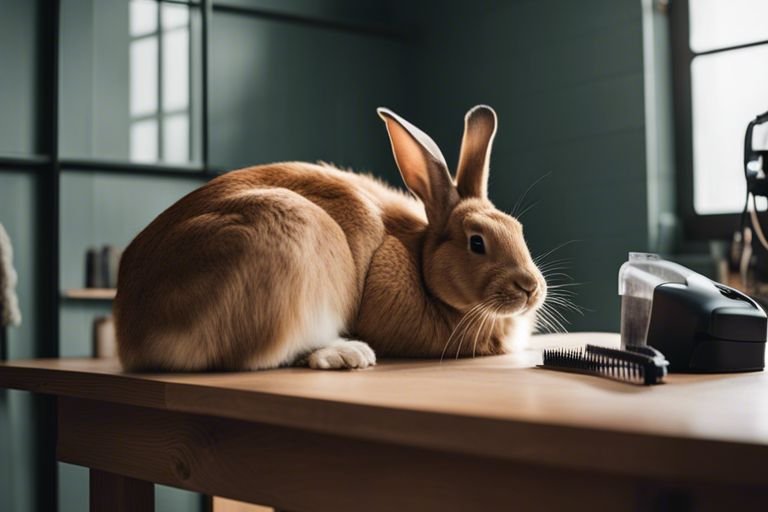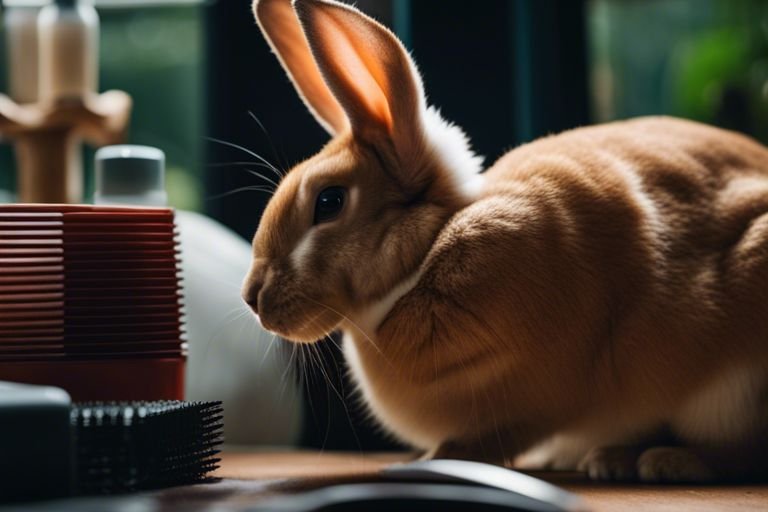Trichophagia, or the act of ingesting hair, can be a dangerous and potentially fatal problem for Flemish Giants. As one of the largest domestic rabbit breeds, these gentle giants are prone to ingesting hair during their regular grooming routines. Excessive hair ingestion can lead to life-threatening gastrointestinal blockages, making it crucial for owners to implement preventative measures. In this blog post, we will explore the importance of grooming routines in preventing hair ingestion in Flemish Giants and provide helpful tips for maintaining their health and well-being.
Key Takeaways:
- Grooming routines play a crucial role in preventing hair ingestion in Flemish Giants
- Frequent brushing and shedding control are essential in minimizing loose hair that the rabbit could ingest
- Regular grooming also helps in maintaining the rabbit’s coat and preventing matting
- Incorporating hairball prevention supplements and providing adequate dietary fiber can also help in reducing hair ingestion in Flemish Giants
- Monitoring the rabbit’s health and consulting a veterinarian if there are concerns about hair ingestion can help in preventing serious health issues
Understanding Flemish Giants
The Flemish Giant is a large breed of domestic rabbit, known for its impressive size and gentle nature. Originating from Belgium, this breed has become popular worldwide for its calm temperament and unique appearance.
The Flemish Giant can weigh up to 14 pounds, making it one of the largest rabbit breeds. Their ears are long and erect, and they come in a variety of colors including black, blue, fawn, and white. Despite their size, they are known for being docile and friendly, making them a popular choice for both pet owners and rabbit enthusiasts.
Characteristics of the Breed
An interesting characteristic of Flemish Giants is their impressive size. This breed is known for being larger than most other rabbits, making them stand out in a crowd. Additionally, their calm and friendly nature makes them great companions for children and adults alike.
One of the most notable characteristics of Flemish Giants is their distinctive appearance, which sets them apart from other rabbit breeds. Their large size and unique coloring make them a popular choice for both rabbit owners and breeders.
Common Health Concerns Related to Ingestion
On occasion, Flemish Giants may experience health issues related to hair ingestion. This can lead to gastrointestinal blockages and other internal complications, which can be dangerous if not addressed promptly. Health monitoring and grooming routines are essential to prevent these issues.
Health concerns related to ingestion, such as hairballs and blocks, are important to be aware of to advocate for the well-being of your Flemish Giant. Regular grooming and monitoring for any signs of distress are key to preventing these potential health complications.
Grooming Techniques
Now, let’s delve into the grooming techniques that can help prevent hair ingestion in Flemish Giants. Regular grooming is essential for these large rabbits to keep their fur clean, healthy, and free from matting.
Brushing and Comb-out Strategies
Brushing and combing are essential grooming techniques for Flemish Giants. Brushing your rabbit’s fur at least once a week helps remove loose hair and prevents mats from forming. Use a slicker brush or a comb with fine teeth to gently remove any tangles or shed hair. Pay close attention to the armpits, tail, and hindquarters as these areas are more prone to matting.
Bathing and Spot Cleaning
Any grooming routine for Flemish Giants should include bathing and spot cleaning as needed. While rabbits generally keep themselves clean, occasionally they may need a bath to remove stubborn dirt or soiling. Use a mild, rabbit-safe shampoo and lukewarm water to gently bathe your rabbit. Additionally, spot clean any soiled areas with a damp cloth to prevent the ingestion of dirt or hair during grooming.
The proper grooming techniques, including brushing, combing, bathing, and spot cleaning, are essential in preventing Flemish Giants from ingesting excessive hair. While these rabbits may groom themselves, regular maintenance from their owners is crucial for their well-being. By following these grooming practices, you can help reduce the risk of hair ingestion in your beloved Flemish Giant.

Dietary Considerations and Supplements
For Flemish Giants, proper dietary considerations and supplements can play a crucial role in preventing hair ingestion. A well-balanced diet high in fiber can help reduce the risk of hairballs and blockages in your rabbit’s digestive system. It’s also important to provide digestive aids to support healthy gut function and minimize the risk of hair accumulation.
Role of Fiber in Preventing Hair Ingestion
For rabbits, a high-fiber diet is essential for maintaining digestive health. By consuming a sufficient amount of roughage, such as hay and fresh greens, rabbits are able to pass hair through their digestive system more easily, reducing the likelihood of hair ingestion leading to blockages. Additionally, fiber helps to promote regular bowel movements, aiding in the expulsion of any ingested hair.
Ensuring your Flemish Giant has constant access to hay can significantly minimize the risk of hairball formation. Can You Shave a Rabbit? Bunny Grooming Done Right
Benefits of Digestive Aids
Ingestion of hair can disrupt normal digestive processes and lead to gastrointestinal issues in rabbits. Providing digestive aids, such as papaya tablets or pineapple juice, can help break down hair in the digestive tract and prevent blockages. These natural enzymes aid in the digestion of food, including any ingested hair, promoting healthy gut function and reducing the risk of hair-related complications.
With the use of digestive aids, the risk of hairball formation and related digestive issues can be significantly reduced, ensuring optimal digestive health for your Flemish Giant.

Creating a Grooming Routine
After bringing a Flemish Giant rabbit into your home, it’s important to establish a grooming routine to prevent hair ingestion and potential health issues. Regular grooming not only keeps your rabbit’s fur in top condition, but it also helps to minimize the amount of loose hair that your rabbit may ingest during self-grooming. By implementing a consistent grooming routine, you can greatly reduce the risk of hair ingestion in Flemish Giants.
Daily and Weekly Grooming Schedules
For daily grooming, it’s important to use a soft bristle brush to gently remove any loose fur and debris from your rabbit’s coat. This will not only maintain the health of your rabbit’s fur but will also help to prevent excessive hair ingestion. In addition to daily brushing, you should also establish a weekly grooming schedule to trim your rabbit’s nails, check for any signs of hair ingestion, and examine their overall health and wellbeing.
Monitoring for Symptoms of Hair Ingestion
For monitoring your Flemish Giant for symptoms of hair ingestion, it’s important to pay close attention to their behavior and any changes in appetite. Keep an eye out for excessive grooming or signs of discomfort, as these could be indicators of hair ingestion. Additionally, regularly inspect your rabbit’s droppings for any signs of abnormality, which could also signal a potential issue with hair ingestion.
Symptoms of hair ingestion can include decreased appetite, lethargy, and changes in bowel movements. If you notice any of these symptoms, it’s important to seek veterinary care immediately to prevent any potential complications from hair ingestion.
Can grooming routines prevent hair ingestion in Flemish Giants?
Upon reflecting on the research, it is evident that regular grooming routines can indeed help prevent hair ingestion in Flemish Giants. By implementing regular brushing and grooming, rabbit owners can mitigate the risk of their pets ingesting large amounts of hair, which can lead to potentially harmful health issues such as blockages in the gastrointestinal tract. Additionally, providing suitable dietary supplements and ensuring proper hydration can further reduce the risk of hair ingestion in these large rabbit breeds. It is important for rabbit owners to be proactive in preventing hair ingestion in their pets to ensure their overall health and well-being.
FAQ
Q: Can grooming routines prevent hair ingestion in Flemish Giants?
A: Grooming routines can help prevent hair ingestion in Flemish Giants by reducing the amount of loose fur on the rabbit’s body. Regular brushing can minimize shedding and decrease the likelihood of the rabbit ingesting large amounts of hair while grooming itself.
Q: How often should grooming be done for Flemish Giants?
A: Grooming should be done for Flemish Giants at least once a week, or more frequently during periods of heavy shedding. Brushing should be gentle to avoid causing stress to the rabbit, and any mats or tangles should be carefully removed to prevent discomfort.
Q: Are there specific grooming tools recommended for Flemish Giants?
A: Yes, grooming tools such as a soft bristle brush or a grooming glove are recommended for Flemish Giants. These tools are gentle on the rabbit’s skin and can effectively remove loose fur. Additionally, a small comb can be used to address any mats or tangles in the rabbit’s fur.
